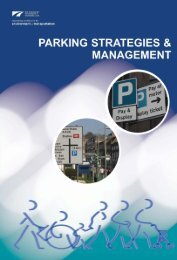Level 2 and 3 Diploma in Business Support (4475-12/13)
Level 2 and 3 Diploma in Business Support (4475-12/13)
Level 2 and 3 Diploma in Business Support (4475-12/13)
You also want an ePaper? Increase the reach of your titles
YUMPU automatically turns print PDFs into web optimized ePapers that Google loves.
Unit 309 Pr<strong>in</strong>ciples of customer service delivery<br />
Learn<strong>in</strong>g outcomes <strong>and</strong> assessment criteria<br />
Outcome 1 Be able to describe the pr<strong>in</strong>ciples which impact on customer<br />
expectations<br />
1 The sectors are public, private or voluntary <strong>and</strong> it is important to underst<strong>and</strong> the similarities <strong>and</strong><br />
differences <strong>in</strong> plann<strong>in</strong>g customer service offers <strong>in</strong> each sector.<br />
Public sector – eg NHS organisations – surgeries, hospitals, hous<strong>in</strong>g departments,<br />
organisations which provide preventative or supportive services where money is not the goal.<br />
Private/commercial sector – eg retail. Here the motivation is to <strong>in</strong>crease profit, attract new<br />
customers <strong>and</strong> build on exist<strong>in</strong>g relationships.<br />
Voluntary/a not-for profit organisation – eg charity. It may still sell goods <strong>and</strong> services <strong>and</strong><br />
aims to attract customers <strong>and</strong> make money for the charity but it is not profit motivated.<br />
2 Customer expectations are what customers th<strong>in</strong>k should happen <strong>and</strong> how they believe they<br />
should be treated when ask<strong>in</strong>g for or receiv<strong>in</strong>g customer service. Expectations are formed:<br />
• through what customers hear <strong>and</strong> see<br />
• what they read <strong>and</strong> the messages the organisation sends (ie via its reputation <strong>and</strong> br<strong>and</strong>)<br />
• by what actually happens to them when deal<strong>in</strong>g now <strong>and</strong> <strong>in</strong> the past with an organisation<br />
Customer expectations are heavily <strong>in</strong>fluenced by word of mouth (eg friends <strong>and</strong> family) <strong>and</strong> the<br />
media.<br />
Customers may have experiences with similar organisations which impact upon their overall<br />
impression <strong>and</strong> expectations of that particular service <strong>in</strong>dustry eg hotels <strong>and</strong> restaurants,<br />
supermarkets, bank<strong>in</strong>g, <strong>in</strong>surance.<br />
3 The c<strong>and</strong>idate should underst<strong>and</strong> customer service is not just about say<strong>in</strong>g ‘yes’ to customers.<br />
They should underst<strong>and</strong> it is necessary to balance the needs of both customer <strong>and</strong> organisation.<br />
This may <strong>in</strong>volve them <strong>in</strong> <strong>in</strong>fluenc<strong>in</strong>g the customer <strong>and</strong> negotiat<strong>in</strong>g with the customer <strong>in</strong> order to<br />
reach agreement.<br />
The c<strong>and</strong>idate should be able to describe how to expla<strong>in</strong> to a customer their needs <strong>and</strong><br />
expectations cannot be met.<br />
Outcome 2 Be able to identify how behaviour, communication <strong>and</strong><br />
<strong>in</strong>terpersonal skills affect customer expectations <strong>and</strong><br />
satisfaction<br />
1 Different behaviours <strong>in</strong> a range of customers will require a service deliverer to adapt their own<br />
behaviour eg when deal<strong>in</strong>g with:<br />
• aggressive behaviour<br />
• confused behaviour<br />
• people who are upset<br />
• frustrated<br />
• worried<br />
• people with special needs<br />
• cultural needs<br />
It is important that negative feel<strong>in</strong>gs do not show. Produc<strong>in</strong>g positive behaviours <strong>in</strong> turn<br />
produces positive attitudes. By adapt<strong>in</strong>g body language one can achieve customer satisfaction.<br />
184 <strong>Level</strong> 2 <strong>and</strong> 3 <strong>Diploma</strong> <strong>in</strong> Bus<strong>in</strong>ess <strong>Support</strong> (<strong>4475</strong>-<strong>12</strong>/<strong>13</strong>)







